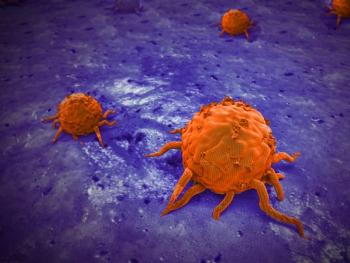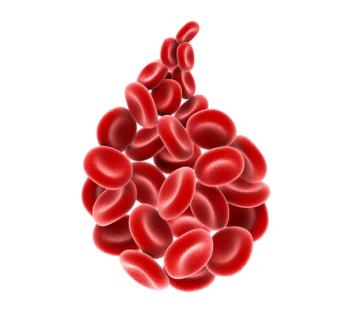
Maintenance With Atezolizumab Combo Is Favorable Compared With Placebo/Chemotherapy in ES-SCLC
Patients with extensive-stage small cell lung cancer show greater response when atezolizumab is added to carboplatin and etoposide versus placebo in the IMpower133 trial.
Updated data regarding overall survival (OS) from the IMpower133 trial (NCT02763579) indicate that maintenance therapy with atezolizumab (Tecentriq) plus carboplatin and etoposide (CP/ET) is superior to placebo and CP/ET for the treatment of extensive-stage small cell lung cancer (ES-SCLC).1
Lead study author Martin Reck, MD, PhD, head of the Department of Thoracic Oncology at the Lung Clinic Grosshansdorf in Germany, presented OS and progression-free survival (PFS) results from the phase 3 trial at the 2020 World Conference on Lung Cancer Singapore.
Investigators found that median OS was longer in the atezolizumab + CP/ET (n = 154) compared with the placebo + CP/ET arm (n = 164) among patients in the maintenance population. The median duration of follow-up was 13.9 months at the April 24, 2018 data cutoff.
The median OS was 15.7 versus 11.3 months in favor of the experimental arm (HR, 0.59; 95% CI, 0.43-0.81). Similarly, median PFS was 5.5 versus 4.5 months in favor of atezolizumab plus CP/ET (HR, 0.64; 95% CI, 0.50-0.82).
Investigators found that the survival benefit associated with atezolizumab held even after adjusting for baseline characteristics for both OS (HR, 0.59; 95% CI, 0.43-0.81; P = .001) and PFS (HR, 0.64; 95% CI, 0.50-0.82; P <0.001).
This study analyzed outcomes in patients who reached the maintenance phase of IMpower 133 (NCT02763579). In the original study, 201 patients were assigned to the atezolizumab group while 202 were assigned to placebo. Both groups received CP/ET. Treatment continued until progressive disease or loss of clinical benefit. Patients with treated asymptomatic brain metastases were eligible.
Three factors were significant predictors for reaching maintenance phase: ECOG performance score (odds ratio [OR], 0.439; P = .004), lactate dehydrogenase level (OR, 0.589; P = .053), and age (OR, 0.459; P = .0T01). Furthermore, investigators concluded that age appeared to have a significant treatment interaction (P = .004).
No new or unexpected safety signals were identified in this analysis. Safety results were comparable between treatment arms despite the continuation of atezolizumab monotherapy in the maintenance phase. From the start of maintenance, 28% of patients in the atezolizumab arm experienced grade 3/4 adverse events (AEs) compared with 23% in the placebo arm. Fifteen percent of patients in the experimental arm experienced serious AEs compared with 12% in the placebo arm.
Thirty (19%) patients assigned to atezolizumab required dose modification or interruption compared with 17 (10%) in the placebo arm.
In the experimental arm, 26% of patients experienced immune-related AEs versus 15% in the placebo arm. There were 2 (1%) cases of grade 3/4 rash and 1 (<1%) of grade 3/4 pneumonitis in the atezolizumab arm. In the placebo arm, there were 2 cases each of grade 3/4 pneumonitis and pancreatitis. There were no grade 5 immune-related AEs reported.
Findings reported at the 2019 ESMO Congress showed that the combination improved long-term OS in this patient population compared with chemotherapy alone. At a median follow-up of 13.9 months, the primary endpoint of median OS was 12.3 months in the atezolizumab plus CP/ET arm compared with 10.3 months in the placebo plus CP/ET arm (HR, 0.7; 95% CI, 0.60-0.95; P = .0154).2
Based on the primary data, atezolizumab was approved as first-line treatment for ES-SCLC by both the FDA (March 2019) and the European Medicines Agency (September 2019).
In the primary analysis published in 2018, the median OS was 12.3 months in the atezolizumab plus CP/ET arm compared with 10.3 months in the placebo plus CP/ET arm (HR, 0.7; P = .007). The median PFS, a coprimary endpoint, was 5.2 versus 4.3 months, respectively (HR, 0.77; P = .02). The survival benefit was observed across all subgroups.3
References:
1. Reck M, Horn L, Mok TSK, et al. IMpower133: Exploratory analysis of maintenance therapy in patients with extensive-stage small-cell lung cancer. Presented at: the 2020 IASCL World Conference on Lung Cancer virtual; January 28-31, 2021. Abstract OA11.06
2. Reck M, Liu SV, Mansfield AS, et al. IMpower133: updated overall survival (OS) analysis of first-line (1L) atezolizumab (atezo) + carboplatin + etoposide in extensive-stage SCLC (ES-SCLC). Presented at ESMO 2019; September 27-October 1, 2019; Barcelona, Spain. Abstract 1736O
3. Horn L, Mansfield AS, Szcesna A, et al. First-line atezolizumab plus chemotherapy in extensive-stage small-cell lung cancer. N Engl J Med. 2018;379:2220-2229. doi:10.1056/NEJMoa1809064
Newsletter
Stay up to date on recent advances in the multidisciplinary approach to cancer.



















































































